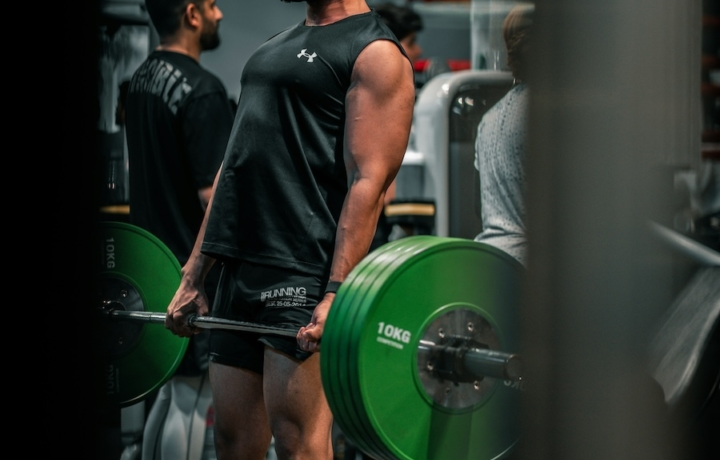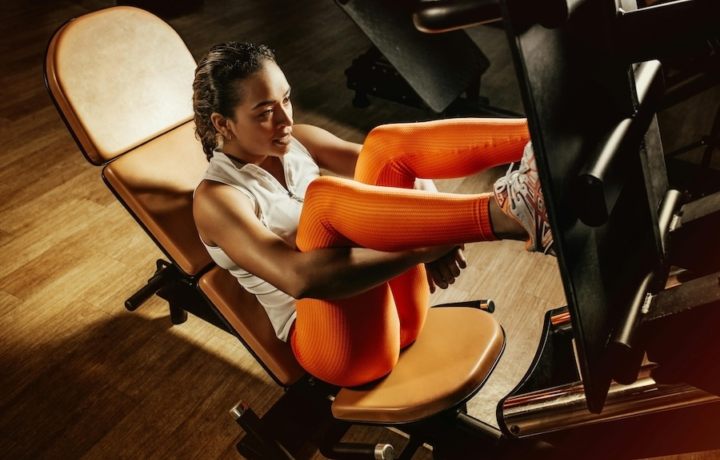Exercise
Dumbbell Single-Leg Glute Bridge

Dumbbell Single-Leg Glute Bridge
How to Perform
- Lie flat on your back with knees bent at a 90-degree angle and feet flat on the floor about hip-width apart.
- Hold a dumbbell securely on your hip bones, using both hands to stabilize it directly over your pelvis.
- Extend one leg straight out at approximately knee height, keeping your foot flexed and leg active throughout the movement.
- Brace your core by drawing your navel toward your spine and maintain a neutral neck position, with eyes looking straight up.
- Exhale as you drive through the heel of your planted foot, pressing your hips upward until your body forms a straight line from shoulders to extended knee.
- At the top position, squeeze your glutes intensely while keeping your supporting knee pointing forward and maintaining level hips.
- Inhale as you slowly lower your hips back to the floor with control, maintaining tension in your glutes throughout the descent.
- Complete all repetitions on one side before switching to the other leg, ensuring equal work on both sides.
Important information
- Keep your supporting foot flat on the floor throughout the entire movement to maintain stability and maximize glute activation.
- Avoid arching your lower back at the top position – focus on using your glutes rather than your lower back to generate power.
- If your hips rotate or dip to one side during the movement, reduce the weight or practice the exercise without a dumbbell until you develop better control.
- Position the dumbbell directly over your hip bones, not on your stomach or too high on your abdomen, to prevent interference with proper hip extension.

Dumbbell Single-Leg Glute Bridge
Exercise Details
Primary Muscles
Muscle Groups
Mechanic
Risk Areas
Built for progress
Take the guesswork out of training
Create personalized AI-powered workout plans that evolve with you. Train smarter, track every rep and keep moving forward, one workout at a time.






The Dumbbell Single-Leg Glute Bridge stands as a remarkable intermediate-level exercise that takes the classic glute bridge to new heights of effectiveness. By isolating one leg at a time and adding the resistance of a dumbbell, this movement creates an intensified challenge that targets the glutes and hamstrings with impressive precision. This unilateral exercise shines in both bodybuilding and HIIT contexts, making it versatile enough for various training protocols. For physique-focused individuals, the single-leg variation creates greater muscle activation in the gluteus maximus and hamstrings compared to the standard bridge, potentially leading to more balanced development and aesthetic symmetry.
When incorporated into high-intensity interval training, it elevates heart rate while simultaneously building lower body strength. The beauty of the Dumbbell Single-Leg Glute Bridge lies in its ability to reveal and correct strength imbalances between your left and right sides. Many of us naturally favor one leg, which can lead to muscle asymmetries over time. This exercise forces each side to work independently, ensuring your non-dominant side catches up and contributes equally to your overall strength profile. From a functional perspective, this movement builds stability through the posterior chain that translates to improved athletic performance.
The strength gained through consistent practice supports everything from sprint speed to jumping power, while simultaneously reinforcing proper hip extension patterns that protect the lower back during daily activities and athletic movements. For those seeking to maximize strength gains, the single-leg variation creates significant tension through a full range of motion with less total weight than would be needed in bilateral movements. This makes it joint-friendly while still delivering the progressive overload necessary for continued improvement. As you advance, simply increasing the dumbbell weight or adjusting tempo can continually challenge your muscles without requiring complex equipment modifications.
FAQ - Dumbbell Single-Leg Glute Bridge
The Dumbbell Single-Leg Glute Bridge primarily targets the gluteus maximus, with significant activation in the hamstrings and core. The unilateral nature of the exercise also engages the hip stabilizers and lower back muscles more effectively than standard bilateral bridges.
Start with a light dumbbell (5-10 lbs) to master the movement pattern before progressing. The ideal weight allows you to maintain proper form for 8-12 reps while still feeling challenged in your core, not your arms or shoulders.
The three most critical errors are allowing the hips to sag (losing the pike position), shoulders rolling forward (compromising joint safety), and excessive body wobbling due to poor core bracing. Focus on maintaining a straight line from hands to hips, keeping shoulders packed away from ears, and engaging your core throughout the movement.
Incorporate this exercise 2-3 times weekly with at least 48 hours between sessions to allow for muscle recovery. It works well as part of a lower-body day or can be added to full-body workouts as a glute-focused accessory movement.
For an easier version, place your feet wider apart on the ball or position the ball closer to your body. To increase difficulty, try performing the movement with one leg raised, holding a weight across your hips, or increasing time under tension by slowing down the movement.








